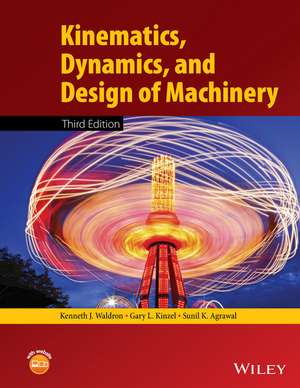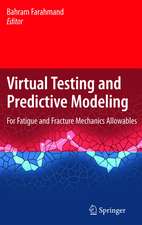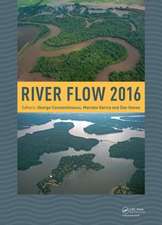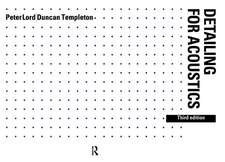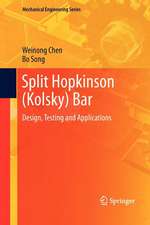Kinematics, Dynamics, and Design of Machinery 3e
Autor KJ Waldronen Limba Engleză Hardback – 9 iun 2016
- Presents the traditional approach to the design and analysis of kinematic problems and shows how GCP can be used to solve the same problems more simply
- Provides a new and simpler approach to cam design
- Includes an increased number of exercise problems
- Accompanied by a website hosting a solutions manual, teaching slides and MATLAB® programs
Preț: 838.01 lei
Preț vechi: 1147.95 lei
-27% Nou
160.37€ • 174.14$ • 134.71£
Carte tipărită la comandă
Livrare economică 22 aprilie-06 mai
Specificații
ISBN-10: 1118933281
Pagini: 718
Dimensiuni: 209 x 279 x 37 mm
Greutate: 1.72 kg
Ediția:3rd Edition
Editura: Wiley
Locul publicării:Chichester, United Kingdom
Public țintă
Primary: Senior undergraduates and graduates in mechanical, automotive and production engineering.Secondary: Researchers and practitioners (designers and operators) in industry.
Cuprins
PREFACE
1 INTRODUCTION
1.1 Historic Perspective
1.2 Kinematics
1.3 Design: Analysis and Synthesis
1.4 Mechanisms
1.5 Planar Linkages
1.6 Visualization
1.7 Constraint Analysis
1.8 Constraint Analysis of Spatial Linkages
1.9 Idle Degrees of Freedom
1.10 Overconstrained Linkages
1.11 Uses of the Mobility Criterion
1.12 Kinematic Inversion
1.13 Reference Frames
1.14 Motion Limits
1.15 Slider–Crank Linkages
1.16 Coupler–Driven Linkages
1.17 Motion Limits for Slider–Crank Mechanisms
1.18 Interference
1.19 Practical Design Considerations
1.19.1 Revolute Joints
1.19.2 Prismatic Joints
1.19.3 Higher Pairs
1.19.4 Cams versus Linkages
References
Problems
2 TECHNIQUES IN GRAPHICAL CONSTRAINT PROGRAMMING
2.1 Introduction
2.2 Geometric Constraint Programming
2.3 Constraints and Program Structure
2.3.1 Required Constraints
2.3.2 Other Constraint Options
2.3.3 Annotations
2.3.4 Use of Drawing Layers
2.3.5 Limitations of GCP
2.4 Initial Setup for a GCP Session
2.4.1 The Effect of Typical Constraints
2.4.2 Unintended Constraints
2.4.3 Layers, Line Type, and Line Color
2.5 Drawing a Basic Linkage Using GCP
2.5.1 Drawing a Four–Bar Linkage Using GCP
2.5.2 Including Ground Pivots and Bushings
2.5.3 Drawing a Slider–Crank Linkage
2.6 Troubleshooting Graphical Programs Developed Using GCP
References
Problems
3 PLANAR LINKAGE DESIGN
3.1 Introduction
3.2 Two–Position Double Rocker Design
3.2.1 Graphical Solution Procedure
3.2.2 Solution Using Graphical Constraint Programming
3.2.3 Numerical Solution Procedure
3.3 Synthesis of Crank–Rocker Linkages for Specified–Rocker Amplitude
3.3.1 The Rocker Amplitude Problem: Graphical Approach
3.3.2 Alternative Graphical Design Procedure Based on Specification of A∗B∗
3.3.3 Use of GCP To Design Crank–Rocker and Crank–Shaper Mechanisms
3.4 Motion Generation
3.4.1 Introduction
3.4.2 Two Positions
3.4.3 Three Positions with Selected Moving Pivots
3.4.4 Synthesis of a Crank with Chosen Fixed Pivots
3.4.5 Design of Slider Cranks and Elliptic Trammel
3.4.6 Order Problem and Change of Branch
3.4.7 Using GCP for Rigid–Body Guidance
3.5 Path Synthesis
3.5.1 Design of Six–Bar Linkages Using Coupler Curves
3.5.2 Motion Generation for Parallel Motion Using Coupler Curve
3.5.3 Cognate Linkages
3.5.4 Using GCP for Path Synthesis
References
Problems
4 GRAPHICAL POSITION, VELOCITY AND ACCELERATION ANALYSIS FOR MECHANISMS WITH REVOLUTE JOINTS AND FIXED SLIDES
4.1 Introduction
4.2 Graphical Position Analysis
4.3 Planar Velocity Polygons
4.4 Graphical Acceleration Analysis
4.5 Graphical Analysis of a Four–Bar Mechanism
4.6 Graphical Analysis of a Slider–Crank Mechanism
4.7 The Velocity Image Theorem
4.8 The Acceleration Image
4.9 Solution by Graphical Constraint Programming
4.9.1 Introduction
4.9.2 Scaling Properties of Velocity Polygons
4.9.3 Using GCP To Analyze Linkages That Cannot Be Analyzed by Classical Means
References
Problems
5 LINKAGES WITH ROLLING AND SLIDING CONTACTS, AND JOINTS ON MOVING SLIDERS
5.1 Introduction
5.2 Reference Frames
5.3 General Velocity and Acceleration Equations
5.3.1 Velocity Equations
5.3.2 Acceleration Equations
5.3.3 Chain Rule for Positions, Velocities, and Accelerations
5.4 Special Cases for the Velocity and Acceleration Equations
5.4.1 Two Points Fixed in a Moving Body
5.4.2 Two Points Are Instantaneously Coincident
5.4.3 Two Are Instantaneously Coincident and In Rolling Contact
5.5 Linkages with Rotating Sliding Joints
5.6 Rolling Contact
5.6.1 Basic Kinematic Relationships for Rolling Contact
5.6.2 Modeling Rolling contact using a Virtual Linkage
5.7 Cam Contact
5.7.1 Direct Approach to the Analysis of Cam Contact
5.7.2 Analysis of Cam Contact Using Equivalent Linkages
5.8 General Coincident Points
5.8.1 Velocity Analyses Involving General Coincident Points
5.8.2 Acceleration Analyses Involving General Coincident Points
5.9 Solution by Graphical Constraint Programming
Problems
6 INSTANT CENTERS OF VELOCITY
6.1 Introduction
6.2 Definition
6.3 Existence Proof
6.4 Location of an Instant Center from the Directions of Two Velocities
6.5 Instant center at a Revolute Joint
6.6 Instant Center of a Curved Slider
6.7 Instant Center of a Prismatic Joint
6.8 Instant Center of a Rolling Contact Pair
6.9 Instant Center of a General Cam–Pair Contact
6.10 Centrodes
6.11 The Kennedy–Aronholdt Theorem
6.12 Circle Diagram as a Strategy for Finding Instant Centers
6.13 Using Instant Centers, the Rotating Radius Method
6.14 Finding Instant Centers Using GCP
References
Problems
7 COMPUTATIONAL ANALYSIS OF LINKAGES
7.1 Introduction
7.2 Position, Velocity, and Acceleration Presentations
7.2.1 Position Representation
7.2.2 Velocity Representation
7.2.3 Acceleration Representation
7.2.4 Special Cases
7.2.5 Mechanisms To Be Considered
7.3 Analytical Closure Equations for Four–Bar Linkages
7.3.1 Solution of Closure Equation for Four–Bar Linkages when Link 2 Is the Driver
7.3.2 Analysis When the Coupler (Link 3) Is the Driving Link
7.3.3 Velocity Equations for Four–Bar Linkages
7.3.4 Acceleration Equations for Four–Bar Linkages
7.4 Analytical Equations for a Rigid Body after the Kinematic Properties of Two Points Are Known
7.5 Analytical Equations for Slider–Crank Mechanisms
7.5.1 Solution to Position Equations When Is Input
7.5.2 Solution to Position Equations When r Is Input
7.5.3 Solution to Position Equations When Is Input
7.5.4 Velocity Equations for Slider–Crank Mechanism
7.5.5 Acceleration Equations for Slider–Crank Mechanism
7.6 Other 4–Bar Mechanisms with Revolute and Prismatic Joints
7.6.1 Slider–Crank Inversion
7.6.2 A RPRP Mechanism
7.6.3 A RRPP Mechanism
7.6.4 Elliptic Trammel
7.6.5 Oldham Mechanism
7.7 Closure or Loop Equation Approach for Compound Mechanisms
7.7.1 Handling Points Not on the Vector Loops
7.7.2 Solving the Position Equations
7.8 Closure Equations for Mechanisms with Higher Pairs
7.9 Notational Differences: Vectors and Complex Numbers
Problems
8 SPECIAL MECHANISMS
8.1 Special Planar Mechanisms
8.1.1 Introduction
8.1.2 Straight Line and Circle Mechanisms
8.1.3 Pantographs
8.2 Spherical Mechanisms
8.2.1 Introduction
8.2.2 Gimbals
8.2.3 Universal Joints
8.3 Constant Velocity Couplings
8.3.1 Geometric Requirements of Constant Velocity Couplings
8.3.2 Practical Constant Velocity Couplings
8.4 Automotive Steering and Suspension Mechanisms
8.4.1 Introduction
8.4.2 Steering Mechanisms
8.4.3 Suspension Mechanisms
8.5 Indexing Mechanisms
8.5.1 Geneva Mechanisms
References
Problems
9 SPATIAL LINKAGE ANALYSIS
9.1 Spatial Mechanisms
9.1.1 Introduction 497
9.1.2 Velocity and Acceleration Relationships
9.2 Robotic Mechanisms
9.3 Direct Position Kinematics of Serial Chains
9.3.1 Introduction
9.3.2 Concatenation of Transformations
9.3.3 Homogeneous Transformations
9.4 Inverse Position Kinematics
9.5 Rate Kinematics
9.5.1 Introduction
9.5.2 Direct Rate Kinematics
9.5.3 Inverse Velocity Problem
9.6 Closed Loop Linkages
9.7 Lower Pair Joints
9.8 Motion Platforms
9.8.1 Mechanisms Actuated in Parallel
9.8.2 The Stewart–Gough Platform
9.8.3 The 3–2–1 Platform
References
Problems
10 PROFILE CAM DESIGN
10.1 Introduction
10.2 Cam–Follower Systems40
10.3 Synthesis of Motion Programs
10.4 Analysis of Different Types of Follower Displacement Functions
10.4.1 Uniform Motion
10.4.2 Parabolic Motion
10.4.3 Harmonic Follower–Displacement Programs
10.4.4 Cycloidal Follower–Displacement Programs
10.4.5 General Polynomial Follower–Displacement Programs
10.5 Determining the Cam Profile
10.5.1 Graphical Cam Profile Layout
10.5.2 Analytical Determination of Cam Profile
References
Problems
11 SPUR GEARS
11.1 Introduction
11.2 Spur Gears
11.3 Condition for Constant–Velocity Ratio
11.4 Involutes
11.5 Gear Terminology and Standards
11.5.1 Terminology
11.5.2 Standards
11.6 Contact Ratio
11.7 Involutometry
11.8 Internal Gears
11.9 Gear Manufacturing
11.10 Interference and Undercutting
11.11 Nonstandard Gearing
11.12 Cartesian Coordinates of an Involute Tooth Generated with a Rack
11.12.1 Coordinate Systems
11.12.2 Gear Equations
References
Problems
12 HELICAL, BEVEL, AND WORM GEARS
12.1 Helical Gears
12.1.1 Helical Gear Terminology
12.1.2 Helical Gear Manufacturing
12.1.3 Minimum Tooth Number to Avoid Undercutting
12.1.4 Helical Gears with Parallel Shafts
12.1.5 Crossed Helical Gears
12.2 Worm Gears
12.2.1 Worm Gear Nomenclature
12.3 Involute Bevel Gears
12.3.1 Tredgold s Approximation for Bevel Gears
12.3.2 Additional Nomenclature for Bevel Gears
12.3.3 Crown Bevel Gears and Face Gears
12.3.4 Miter Gear
12.3.5 Angular Bevel Gears
12.3.6 Zerol Bevel Gears
12.3.7 Spiral Bevel Gears
12.3.8 Hypoid Gears
References
Problems
13 GEAR TRAINS
13.1 Gear Trains
13.2 Direction of Rotation
13.3 Simple Gear Trains
13.2.1 Simple Reversing Mechanism
13.4 Compound Gear Trains
13.4.1 Concentric Gear Trains
13.5 Planetary Gear Trains
13.5.1 Planetary Gear Nomenclature
13.5.2 Analysis of Planetary Gear Trains Using Equations
13.5.3 Analysis of Planetary Gear Trains Using Tabular Method
13.6 Harmonic Speed Reducers
References
Problems
14 STATIC FORCE ANALYSIS OF MECHANISMS
14.1 Introduction
14.2 Forces, Moments, and Couples
14.3 Static Equilibrium
14.4 Free–Body Diagrams
14.5 Solution of Static Equilibrium Problems
14.6 Transmission Angle in a Four–Bar Linkage
14.7 Friction Considerations
14.7.1 Friction in Cam Contact
14.7.2 Friction in Slider Joints
14.7.3 Friction in Revolute Joints
14.8 In–Plane and Out–of–Plane Force Systems
14.9 Conservation of Energy and Power
14.10 Virtual Work
14.11 Gear Loads
14.11.1 Spur Gears
14.11.2 Helical Gears
14.11.3 Worm Gears
14.11.4 Straight Bevel Gears
Problems
15 DYNAMIC FORCE ANALYSIS
15.1 Introduction
15.2 Particle Kinetics
15.2.1 Dynamic Equilibrium of Systems of Particles
15.2.2 Conservation of Energy
15.2.3 Conservation of Momentum
15.3 Dynamic Equilibrium of Systems of Rigid Bodies
15.4 Flywheels
Problems
16 STATIC AND DYNAMIC BALANCING
16.1 Introduction
16.2 Single Plane (Static) Balancing
16.3 Multi–plane (Dynamic) Balancing
16.4 Balancing Reciprocating Masses
16.4.1 Expression for Lumped Mass Distribution
16.4.2 Balancing a Slider–Crank Mechanism
16.5 Expressions for Inertial Forces
16.6 Balancing Multi–Cylinder Machines
16.6.1 Balancing a Three–Cylinder In–Line Engine
16.6.2 Balancing an Eight Cylinder V Engine
16.7 Static Balancing of Mechanisms
16.7.1 Gravity Balancing of Planar Mechanisms: Examples
16.7.2 Gravity Balancing Orthosis (GBO)
16.8 Reactionless Mechanisms
References
Problems
17 INTEGRATION OF DIGITALLY CONTROLLED ACTUATORS
17.1 Introduction
17.2 Computer Control of Linkage Motion
17.3 The Basics of Feedback Control
17.4 Actuator Selection and Types
17.4.1 Electrical Actuation
17.4.2 Hydraulic Actuation
17.4.3 Pneumatic Actuation
17.5 Hands–on Design Laboratory
17.5.1 Examples of Class Projects
References
Problems
INDEX
Descriere
Kinematics, Dynamics, and Design of Machinery, Third Edition, presents a fresh approach to kinematic design and analysis and is an ideal textbook for senior undergraduates and graduates in mechanical, automotive and production engineering
- Presents the traditional approach to the design and analysis of kinematic problems and shows how GCP can be used to solve the same problems more simply
- Provides a new and simpler approach to cam design
- Includes an increased number of exercise problems
- Accompanied by a website hosting a solutions manual, teaching slides and MATLAB® programs
